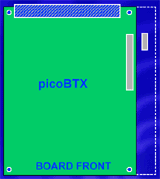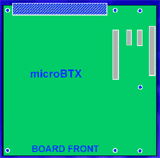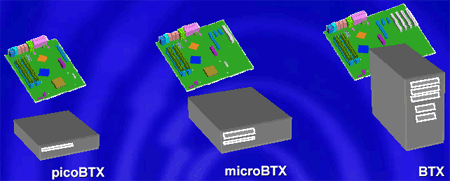Balanced Technology eXtended (BTX) Form Factor - The Future of Cases & Motherboards
by Anand Lal Shimpi on September 18, 2003 12:34 PM EST- Posted in
- Cases/Cooling/PSUs
Three different BTX sizes
Much like the multiple sizes of ATX (micro, flex, etc...), the BTX form factor allows for multiple versions of the form factor. In terms of motherboard sizes, there are three types: picoBTX, microBTX and regular BTX.
Although the board pictures below are obviously not to scale (the BTX board is clearly larger than the picoBTX board), the idea is to show you the difference in expansion slots between the boards.
 |
 |
 |
8.0" x 10.5" |
up to 10.4" x 10.5" |
up to 12.8" x 10.5" |
The picoBTX standard can support either one or two expansion slots and has four mounting holes. PicoBTX cases will probably have one 3.5" and one 5.25" drive bay.
The microBTX standard, which most are expecting to be the more popular of the three, has support for four expansion slots and has seven mounting holes. MicroBTX cases will feature one 3.5" bay and up to two 5.25" bays.

Finally we have the regular sized BTX, supporting up to a full 7 expansion slots and mounts to the case using 10 mounting screws. Regular BTX cases will be more like the mid-tower ATX cases we have today, supporting 3+ 3.5" bays and 3+ 5.25" bays.

The BTX standard allows for two case heights - Type I and Type II. Type I cases are 3.98" in height and can use normal expansion cards, while Type II cases are for small form factor designs and are 3.0" in height. Expansion cards would either use risers or be low profile in a Type II case.

The rear of a microBTX case, you can see the circular heatsink in the thermal module.










99 Comments
View All Comments
Anonymous User - Thursday, September 18, 2003 - link
so what you have to take out the video card to get the cpu that just does not make senseAnonymous User - Thursday, September 18, 2003 - link
This ain't innovation. Innovation is a USB vagina!Anonymous User - Thursday, September 18, 2003 - link
I also don't see the 'innovation' in this. All they have done is move the position of things to suit the needs of current components and maybe those to come for another few years and optimise the airflow which should have been done the first time with ATX. At least tower case users will probably be able to say that it puts the heatsink unit on their graphics card the right way up, but for the desktop this is a pointless change.Also, what about all those people who have invested heavily in cases, such as those with all aluminium alloy cases costing over $200... I'm suspecting there to be a huge demand in ATX motherboards for some time mainly because if new BTX cases are made like brand new ATX cases, they will be flimsy and pretty much rubbish in everything except having stupid plastic stuck over the front to give it 'style'.
Anonymous User - Thursday, September 18, 2003 - link
Nice article, Anand, but this looks like nothing more than a re-hashed WTX form factor. For those who don't know what WTX was...it was just like this new BTX, but without the PCI-express. It flopped like a fish out of water and also soon died. I think we should just stick with ATX micro-ATX, and flex-ATX.idsanity - Thursday, September 18, 2003 - link
Any word on if BTX will eliminate the need for the extra 12v power connector and will it include a standardized connector for front panel cabling?Anonymous User - Thursday, September 18, 2003 - link
Jeeeez. What a waste of time and energy. They call this innovation? All they did was move the CPU to the most advantageous position on the board and let everybody else scramble for what was left. Any moron could have done this. As a matter of fact if you look at a few of the old Compaq's (Crapaq) you will see that they directed the PS exhaust over the CPU and chipset heatsinks. Same difference, but the PS was first. Besides, if the ambient temp is 115F the "active" cooling doesn't work very well anyway. It's time for someone without a full time job to come up with the gas phase change cooling system that works intelligently. All you have to do to control condensation on an A/C system is determine incoming coolant temp with current die temp to make sure the system isn't overcooling. You could even use a condensation detection circuit as a backup. Too many electrical geeks trying to do the mechanical geeks job of cooling gets you nothing more than more, bigger, slower fans. Why not just make a pretty computer with no case at all. How about we just make a decent server and mount it in the cooling vent of my central air. Just brainstorming here, but dang, it's not that hard.Anonymous User - Thursday, September 18, 2003 - link
wtf? those pictures of cases were backwards! That's gonna get confusing.And in regards to the comment about Dells being quiet, as the not-so-proud owner of a Dimension 8200 I would like to differ. It's not quite what you'd call 'silent'.
But yeah, all that new stuff looks cool. Anyone know if there are any other companies working on the standard along with intel?
marc1000 - Monday, March 25, 2013 - link
10 years later, BTX is dead, mini-ITX is here. I personnaly own a Micro-ATX and think it's perfectly fine.CZroe - Tuesday, July 2, 2013 - link
"...the final nail in the coffin of boring computers will be driven by BTX. "I was going to laugh at how prophetic this wasn't until I realized how prophetic it was. Back then I believed it too and even bought the first Cooler Master Stacker (convertible to BTX). Even though BTX never made it, it did put the final nail in the coffin on boring ATX designs as they incorporated much of the BTX ideas in enthusiast cases, like those with upside-down PSU/motherboard designs. Yes, these "exciting" cases may not conform to ATX spec but they fit ATX boards and incorporate many BTX advances.